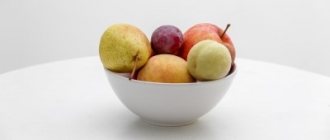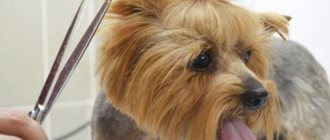Sometimes the owner himself has to feed newly born puppies. A number of reasons can lead to this situation: the death or illness of the mother, too many babies in the litter, the bitch’s refusal to feed.
Whatever the reasons for what happened, the small organism needs care, protection and proper nutrition, which would help it grow into a healthy and happy dog. To ensure a good future for your pet, you need to select a special mixture and meet all the conditions.
The need to introduce complementary feeding to puppies at different ages
Before we figure out when to feed puppies, let's look at the need to introduce new foods. It depends on the age of the animal.
Up to 1 month
Newborns are raised by their mother. Until 1 month, she takes on all feeding concerns. Outside help is required only if there is a shortage of milk, a categorical refusal to feed one's own cubs, or the death of a dog.
Ready-made milk formulas are sold in veterinary pharmacies and pet stores. Their composition is as close as possible to the original.
Artificial feeding with cow's or goat's milk is only permissible as an emergency option for a couple of days, since these products do not contain the necessary vitamins.
INTERESTING!
In addition to the composition, fat content is important. In dog milk it reaches 9.5%, and in cow and goat milk - 3.3% and 3.8%, respectively.
After 1 month
On average, breastfeeding lasts up to 2-2.5 months. Despite this, it is gradually losing its benefits. The amount of milk is also reduced. Because of this, babies may be stunted. At this stage, complementary foods come to the rescue.
Grown-up cubs begin to become interested in the food in their mother's bowl, but not all adult food suits them. For this reason, the owner should be responsible for preparing the diet and feeding regimen.
Constipation
Constipation in very young dogs is considered an extremely dangerous disorder of the body, since intoxication develops very quickly, due to which the baby may die in a few days.
There are several reasons why such trouble can occur in artificially fed puppies:
- Lack of beneficial bacteria. Part of the inoculation into the intestines and stomach is done during childbirth, but the animal receives most of the beneficial bacteria in the first hours of life along with colostrum, which is not so much a nutritional cocktail as a landing of the necessary microorganisms. If the animal does not receive them, then problems with digestion will be ensured.
- Lack of stimulation. In the first weeks of life, the baby himself is not able to go to the toilet. His mother helps him with this, licking the anus and urethra after each feeding. If for some reason the baby is left without the care of his mother, then you will have to take on this responsibility.
- Wrong nursing cocktail.
- The transition from milk food to adult food at the age of 1 month also causes digestive problems. This is quite understandable, since the already established microflora needs to adapt to working with coarser foods of various types and learn to assimilate it.
To avoid such problems, you must:
- Use special mixtures containing bacteria necessary for digestion.
- After each meal, massage the lower part of the tummy to provoke bowel and bladder emptying. Mom also does this in order to clean the puppy, so it would be best to manipulate a cotton pad soaked in warm water or a heated napkin in order to simultaneously stimulate and wash away the effects.
- Keep the box they live in clean.
When to start feeding puppies
20-25 days after birth, animals develop their first milk teeth. From this moment on, they begin to be fed with ready-made food or natural food. All food must be warmed to room temperature and ground into pulp, since the incisors are not suitable for chewing.
The less breast milk, the earlier you need to start feeding. Problems with lactation occur when a large litter is born, the mother has illnesses, or her feeding is poor.
Find a foster mother
If the puppies cannot be raised by their own mother, you can try to find them a foster who has also recently given birth. So that she does not reject them and recognizes them as her own, you can resort to cunning. For example, try rubbing the puppies with that dog's bedding to give them a familiar scent. Or lightly brush them with her breast milk. If none of these tricks work, you need to take other people's puppies and a couple of relatives. When they start whining, return them to the dog all together. But, if even after this she does not allow other people’s puppies to come near her, a person will have to feed them.
Diet and complementary feeding regime for puppies
When choosing complementary foods, focus on what you will feed your pet in the future. The regime also plays a significant role. It allows you to avoid starvation and overfeeding.
Ready-made feeds and starters
The most convenient and safest option is ready-made feed and starters. These include canned pates, meat pieces in jelly and dry granules.
“ Starters are designed specifically for feeding babies. They are introduced into the diet from the 3rd week of life, and after 2 months they are replaced with an analogue for older pets. They differ from other feeds in their higher calorie content and more fortified composition.
Unlike “natural” food, ready-made food does not take the owner’s time to prepare and does not require preliminary calculation of the KBZHU. The daily food intake is already indicated on the packaging by the manufacturer. No additional vitamin supplementation is required, since such a diet contains all the necessary elements.
Dry feeding has only one significant drawback - not all products presented in stores are equally healthy. The listed advantages are offered by premium, super-premium and holistic food. Products marked “economy” require the inclusion of additional vitamins.
IMPORTANT!
When consuming dry diets, a four-legged pet receives only 8-12% of its norm. He receives the rest of his liquid reserves from ordinary water.
Natural food
A natural type of feeding is also possible, but it has a lot of pitfalls. Incorrect calorie counting, lack of proteins, fats or vitamins can result in serious problems for the baby’s health.
If you decide to choose a “natural” breed, be sure to consult with a veterinarian or breeder. They will help you figure out the correct ratio of BZHU and the procedure for introducing new products.
Please note that with such a diet, you will still have to add vitamin and mineral complexes to your diet. It will also take a lot of time to cook, because stale or improperly prepared food can lead to poisoning, infection with parasites and other dangerous consequences.
Prohibited Products
Another disadvantage of “natural” is a large number of prohibited products. These include:
- garlic and onion;
- sorrel;
- berries and fruits with seeds;
- raisins, grapes and mushrooms;
- small and tubular bones;
- spices and smoked meats;
- fat meat;
- millet, pearl barley and legumes;
- semolina, citrus fruits and confectionery;
- baked goods and pasta.
Also, as most animals grow older, they develop lactose intolerance, which causes bloating, diarrhea, increased gas formation, colic and other unpleasant symptoms. Because of this, they should not consume whole milk.
Daily food intake
The serving size depends on the age and weight of the baby. It can be calculated in grams or calories. When dry feeding, it is enough to adhere to the norms on the packaging. If your pet quickly gains weight or weighs less than necessary, the portion can always be adjusted taking into account the activity of the animal.
When feeding natural food, you should focus on 6-7% of the animal’s weight or its age:
- up to 2 months – 220 kcal per 1 kg;
- from 2 to 3 months – 265 kcal per 1 kg.
The resulting figures serve as a general guide. They can and should also be corrected if obesity or excessive thinness is suspected. The easiest way to navigate is by the ribs. They should be clearly palpable, but not visually protruding.
How many times a day should puppies be fed?
Newborn puppies are fed 8 times with a break for night feeding, monthly ones - 6-7 times, and two-month old ones - 5-6 times. In the future, the number of meals is gradually reduced in order to reach the adult norm by 10-12 months, that is, 2 times a day.
Step-by-step description of the procedure
Most often, dogs are bottle-fed with a nipple, but for small breeds a syringe and dropper are also suitable. The feeding procedure consists of the following steps:
- Disinfection. To avoid infecting babies, the owner must thoroughly wash their hands with soap and boil the milk container.
- Warming up. Powdered milk is diluted with water before each feeding and brought to a temperature of 38-40°C. If in the end there is something left in the bottle, then it is poured out.
- Correctly picking up a puppy. The small pet is placed on the lap with its tummy down and its head is gently lifted, imitating the natural position when suckling the breast.
- Putting down the bottle. It is held at an angle of 45°, avoiding too much pressure. Otherwise, the baby may choke. If the puppy himself tries to drink everything in one gulp, then take several forced breaks.
- Helps remove excess air. Once fed, the four-legged animal immediately turns away from the nipple. At this point, its position is changed to vertical and held for about 2 minutes until regurgitation.
A well-fed baby is placed in the opposite direction from his hungry brothers. This way you won’t confuse those who ate and those who didn’t – this especially helps if there are a lot of “babies” in the litter.
ADVICE!
If your pet pushes the pacifier away with its paws, swaddle it, limiting its mobility.
A hole in the nipple is punched with a hot needle. It shouldn't be too big or too small. Puppies should suckle easily without exerting too much force. If the liquid flows freely in a stream, make the hole smaller.
How to wean babies off breast milk
At first, complementary feeding is combined with breastfeeding. Having aroused interest in new products, small pets begin to be fed separately. For serving, use flat plates from which you can easily take food. The amount of feed should be about 10% of the daily requirement.
The fed cubs are transferred to their mother and their behavior is observed. At first, they will have little interest in unfamiliar food and will be much more interested in suckling at the breast. Despite this, everything will change very soon.
“The easiest way to wean off is in a group. If at least one baby likes complementary foods, then everyone else will quickly follow suit.
If you defiantly ignore it, the softened and heated paste can be placed on the tongue or gently spread on the palate. Remember that your pets do not yet know how to eat on their own and they need your help even for such simple actions.
Avoid pressure. Forcing someone against their will will not bring the desired result, but will only slow down the process of weaning.
On average, weaning takes 2-3 weeks. During this time, the amount of feed is gradually increased from 10% to 100% of the daily requirement.
Feeding after weaning
If in the first weeks the main and only food is mother’s milk and substitutes, if necessary, then from the 5th week of life foreign products are gradually introduced, since the amount of maternal nutrition gradually decreases, and the need for nutrients necessary for the structure of a healthy body increases with each an hour.
Complementary feeding is introduced to animals gradually, starting with the closest products: dairy, meat, eggs. It is better to find out the most accurate proportions by talking on a specialized forum with breed breeders.
This takes into account daily needs, as well as the appearance of the food.
In the first weeks after weaning or when bottle-fed during the transition to solid food, puppies are fed:
- Meat . At least 1/3 of the diet consists of it. Choose lean cuts of beef or lamb. It is taken into account that in the natural environment, for the first time, a dog regurgitates meat products to the cubs, since their stomach is not yet able to digest whole pieces. Grind the food into mince or very small pieces, otherwise indigestion and constipation may occur.
- Dairy products: cottage cheese, yogurt, kefir. It is with them that, as a rule, complementary feeding begins. At the same time, you can give milk for up to six months, even cook porridge with it. After this, most often it ceases to be absorbed and leads to diarrhea. And kefir and cottage cheese will accompany your pet all his life. They are given in their pure form as a separate feeding.
- Eggs in small quantities, no more than 2 pieces for a small or medium-sized animal. They are especially useful for artificial people. In the first six months, you should avoid giving raw eggs; they are best digested in the form of an omelet.
- Broths and soups can be introduced as early as 2 weeks after the start of complementary feeding. They are quite nutritious and beneficial for digestion. You can add a variety of cereals and vegetables to them. Soup is a great way to transition from liquid food to solid porridge.
Rules for switching to dry food
A complete transition to dry food with abandonment of mother's milk is practiced at 2-2.5 months. Until this moment, the baby is introduced to the new product through feeding.
When to start feeding puppies dry food
The first acquaintance is organized from 3 weeks of life. The pet is given a pre-soaked starter and wet canned food. Feeding too early is useless, since the newborn’s stomach is adapted to only one type of food - mother’s milk. He simply cannot digest everything else.
Appropriate place
The puppy (or puppies) need to be provided with a comfortable and warm place in a draft-free room where he will stay for the first weeks of his life. For a bed, for example, you can use a box or a wicker basket. Diapers are placed there, which must be changed regularly, since usually the mother maintains cleanliness by licking her offspring, and without her the baby will dirty the bedding. You should put a heating pad or a bottle of hot water in the bed, wrapped in a towel so that the puppy does not get burned. And change the water as soon as it cools down. This way you can imitate the warmth of your mother.
Possible problems
Even with strict adherence to all of the above recommendations, a number of problems may arise during the care process. These include:
- Lack of satiety or overfeeding.
The first condition is easily recognized by the lack of weight gain, restless sleep and constant whining, and the second by greenish stool.
- Constipation or diarrhea.
In addition to consistency, you should monitor the color. If the natural shade has changed, consult your veterinarian
- Insufficient weight gain.
On days 8-10, the initial weight doubles. If there are no changes, your pets should be booked for examination at the nearest veterinary clinic - or invite a specialist to your home.
- Hypoglycemia, or low blood glucose levels.
The risk group includes dwarf breeds. The main symptoms are loss of appetite, chills, abnormal bowel movements, weakness, unsteadiness of gait.
- Inflammation of the navel.
Develops when asepsis is not observed during childbirth and the “nest” is not regularly cleaned. Without timely treatment, inflammation is complicated by sepsis.
- Conjunctivitis.
Occurs when the palpebral fissure becomes infected before it opens. The main symptoms are purulent discharge, swelling and redness of the eyelids.
- "Swimmer's Syndrome"
A genetic disorder that appears at 2-3 weeks of birth. A sick pet is unable to stand on its legs and makes “swimming” movements with them.
- Dehydration.
In addition to a lack of fluid in the diet, it is provoked by low humidity in the room.
Despite some difficulties, artificial feeding is almost as good as natural feeding. By preparing a high-quality diet, observing the frequency of feeding and proper care of newborns, you can raise healthy and strong dogs, no different from those who grew up with their mother.
Do you like the article? 0











